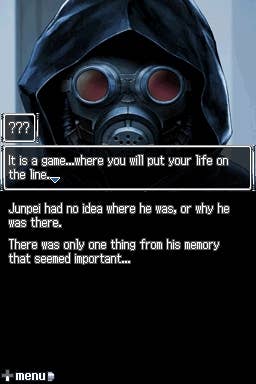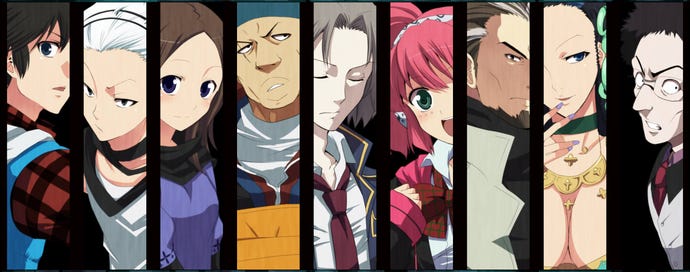JPgamer: In Search of Door Number 9
In this week's JPgamer, Pete delves into his backlog to explore one of the most interesting games on the Nintendo DS: Chunsoft's visual novel-cum-room escape adventure Nine Hours, Nine Persons, Nine Doors.
This article first appeared on USgamer, a partner publication of VG247. Some content, such as this article, has been migrated to VG247 for posterity after USgamer's closure - but it has not been edited or further vetted by the VG247 team.
I have a problem, dear reader, and I'm sure it's one to which many of you can relate: a sizeable backlog.
I'm making a point of getting through it a tiny bit at a time, though -- particularly now the new consoles are here -- and, as I expected I would, I'm discovering some real gems in the process, one of which I'd like to talk about today.
The game in question is Chunsoft's Nine Hours, Nine Persons, Nine Doors, or 999 to its friends. It's a Nintendo DS game that originally came out back in 2010 (2009 in Japan), and I got a copy for Christmas two years ago which has been sitting unopened on my shelf ever since -- it's one of those boxes that I'd see occasionally and think "oh yeah, I really should play that," and then go and get absorbed in some ridiculous candy-colored JRPG for a hundred hours instead. We've all been there. Right? Right?
But no, this time around I decided I was going to start it, I was going to play it and dammit, I was going to finish it. And indeed I have. Pleasingly, it didn't take all that long, either, which kind of makes me wish I'd tried it a bit sooner, but, well, you can't turn back the clock, and at least now I have its sequel Virtue's Last Reward to look forward to.

But what of 999 itself? Well, read on. Spoilers will be kept to a minimum for those who haven't played it.
In 999, you're cast in the role of Junpei, a young man who finds himself locked in a cabin on a boat. After escaping from his cabin, he comes across eight other individuals who have been brought aboard at the behest of the mysterious "Zero" to partake in an activity known as the "Nonary Game." The Nonary game is simple: all nine participants have nine hours to discover a door marked with a number 9, which provides them with their route to escape. Their route to door 9 is blocked by numbered doors, each of which can accommodate between three and five people, and the only way to open a numbered door is for the participants to use their numbered bracelets to "verify" and make a digital root equal to the number on the door. (Don't worry about the math side of things; it's largely taken care of for you, with the exception of a few explicit puzzles.)
999 blends visual novel storytelling sequences with room escape adventure sequences, making it an extremely Japanese game in terms of game mechanics. You'll spend about 80% of your time in the game reading reams of text, and the other 20% finding bizarre items and using them to get out of whatever room you've been locked in this time.
The visual novel sequences make excellent use of the DS' two screens for effective presentation, eschewing the usual "stuff happens on the top screen, interface is on the bottom" approach adopted by similar games such as the Ace Attorney series. Instead, 999 uses the top screen to present dialogue, characters and event images, while the bottom screen is reserved for narration.

Interestingly, 999's narration doesn't take the usual visual novel approach of narrating everything from the first-person perspective of the protagonist Junpei. Instead, the narration unfolds from a third-person perspective, though remains constantly focused on Junpei rather than the other characters involved. Junpei has his own internal monologue that shows up on the top screen while he's working out how to solve the room escape sequences -- or rather, you are -- but for the most part the narration is more like that you'd find in a conventional third-person, past-tense novel rather than the first-person present tense usually seen in other visual novels.
There is a fascinating reason for this interesting stylistic choice -- and a few other events that are otherwise unexplained -- that is only revealed in the game's true ending, and getting to that point is something of an ordeal, albeit an enjoyable one. 999 has six endings, you see, three of which involve most, if not all, of the main cast dying horribly, one of which ends with a cliffhanger that is only resolved in the true ending and one of which is a prerequisite to seeing the aforementioned true ending. Technically all of the non-true endings are "bad" to some degree or another, but 999 adopts a common approach seen in many visual novels, in that "bad" doesn't necessarily mean "undesirable."
In fact, the routes that lead up to 999's various endings each impart to you different pieces of the complete story, and it's only by following all the possible combinations of routes through the game that you can get a complete picture of what is really going on -- play through the game once and you may see an ending, sure, but it won't be a "good" one; you'll have to play through at least twice in total to get the truth, and preferably six times altogether to see absolutely everything.
This is an interesting approach, and one that relies on the player having a degree of self-discipline as well as sufficient curiosity to go back and replay the game. Fortunately, a single playthrough doesn't take all that long and the game provides a "fast forward" function allowing you to skip text you've already seen, so while you do have to repeat some material a couple of times, it's a relatively painless experience.

One of the main reasons this is interesting, though, is that it's an expression of trust between developer -- or, perhaps more accurately, writer -- and player. In other words, not everything is presented on a plate to the player, and it's entirely possible to reach the end without being able to come to any firm conclusions as to what happened; the writer is trusting the player to seek out the additional knowledge they need by playing the game again. This is something that Western developers often shy away from; with the exception of titles from BioWare, it's relatively rare for a Western game to have multiple endings and expect the player to piece together the complete story from the fragments presented by each distinct conclusion. Conversely, it's rather common in Japanese media, with the majority of visual novels having multiple routes through the story, each of which are markedly different from one another, and many RPGs having a variety of different possible conclusions, too.
In 999's case, it doesn't take long for it to become clear that taking alternative routes at the game's relatively few important decision points will have a major impact on how the story unfolds, though it isn't at all apparent when you first play which options are the "right" ones. Part of the joy of the game is in discovering where each of the paths lead you, and which characters this allows you to spend more time with and consequently learn more about.
Speaking of characters, 999's cast is a fascinating bunch that eschews common visual novel stereotypes in favor of a diverse selection from all walks of life. These characters frequently defy the expectations and prejudices you might have towards them based solely on their visual appearance, too; it's rare that all is as it seems with each of the cast members, and indeed this is a key theme of the story as a whole. In fact, such is the degree of mystery surrounding each character that you spend a significant proportion of the game trying to work out exactly who these people are, and who -- if anyone -- might be a threat to the group's escape attempt as a whole.
Multi-ending visual novels are often structured in such a way that regardless of plot and theme, their narrative paths tend to coincide with pursuing a particular character romantically -- Sweet Fuse is a good example -- but 999 again eschews this approach in favor of each path simply exploring the narrative as a whole in greater depth. In some paths, you'll get more information on the specific characters' backgrounds; in others, there's broader exploration of the background to the game's overall plot. While you can see the game's true ending after just two playthroughs, it's actually desirable to seek out the alternative pathways through the game, even if they end in horrible bloody death, because each new piece of story reveals a piece of the greater puzzle.
In short, then, if you're a fan of story-based gaming and you're yet to play your way through 999, I strongly recommend setting aside 10-15 hours or so and working your way through its compelling, multi-layered narrative. I can't speak for the quality of its sequel Virtue's Last Reward as yet -- after finishing 999 today, that's next in the queue -- but 999 is certainly a fine example of the video games medium being used effectively to tell an interesting and unusual story in a rather unconventional manner, and it's an experience well worth having.




